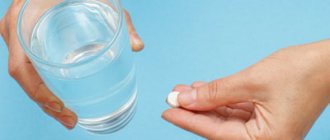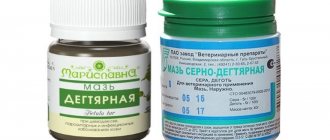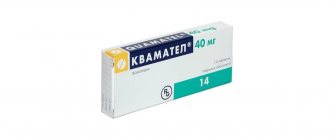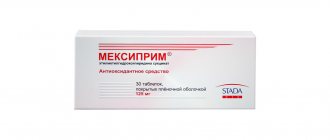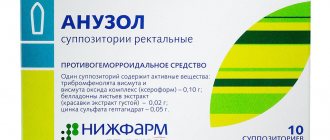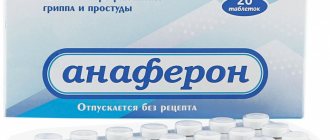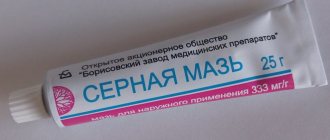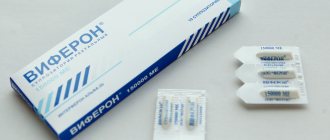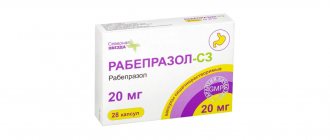Pain or fever may appear suddenly, causing a person a lot of discomfort. Combination drugs cope more successfully with different types of pain, inflammation and hyperthermia. What Askofen helps with and how many tablets you need to take to achieve the effect, we will consider further.
Release form, composition
Currently, Askofen is presented in pharmacies in two forms: Askofen-P and Askofen ultra. Both drugs are available only in tablets and have the same composition. The only difference is in the dosages.
- Askofen-P contains 200 mg of paracetamol, 40 mg of caffeine and 200 mg of acetylsalicylic acid;
- Askofen Ultra contains 250 mg of paracetamol, 65 mg of caffeine and 250 mg of acetylsalicylic acid;
Excipients include potato starch, stearic acid, calcium stearate, povidone, talc, petroleum jelly and silicone emulsion. The tablets have a white or white-pink color, a flat cylinder shape, a chamfer and a score, a slight or no odor is allowed, and a marbled color.
Sold 10 or 20 pieces per pack.
Askofen-Darnitsa
CONFIRMED
Order of the Ministry of Health of Ukraine
08.12.2017 № 1570
Registration update
№ UA/7528/01/01
INSTRUCTIONS
for medical purposes
A skofen-Darnytsia
( Ascophen -Darnitsa)
Stock:
active ingredients: acetylsalicylic acid, paracetamol, caffeine;
1 tablet containing: acetylsalicylic acid 200 mg, paracetamol 200 mg, caffeine 40 mg;
additional ingredients: citric acid monohydrate, potato starch, povidone, calcium stearate.
Medicine form. Pills.
Main physical and chemical properties: white-colored tablets, flat-cylindrical in shape, with a chamfer and a score. Marmuriness is allowed on the surface of the tablets.
Pharmacotherapeutic group. Analgesics. Other analgesics and antipyretics. Acetylsalicylic acid, combinations without psycholeptics. ATX code N02B A51.
Pharmacological power.
Pharmacodynamics.
The doctor's task is to perform analgesic, antipyretic and anti-inflammatory actions. The components that enter the medical warehouse have the same effect.
The antipyretic effect of acetylsalicylic acid is realized through the central nervous system by inhibiting the synthesis of prostaglandins PGF2 in the hypothalamus in response to the influx of endogenous pyrogens. The analgesic effect may be both peripheral and central: the peripheral effect is a suppression of the synthesis of prostaglandins in inflammatory tissues; The central effect is an influx into the center of the hypothalamus. Acetylsalicylic acid also reduces platelet aggregation.
Paracetamol has an analgesic, antipyretic and mild anti-inflammatory effect, which is associated with its effect on the center of thermoregulation in the hypothalamus and a weakly expressed effect of inhibiting the synthesis of prostaglandins in peripheral tissues.
Caffeine stimulates the central nervous system. It also enhances positive mental reflexes, stimulates brain activity, weakens the effects of drugs and drugs, and enhances the effects of analgesics and antipyretics.
Pharmacokinetics.
I didn’t screw around.
Clinical characteristics.
Showing.
Therapy for mild or mild pain syndrome: for headache or toothache, neuralgia, myalgia, arthralgia, for primary dysmenorrhea, as well as antipyretic treatment for illnesses that are accompanied by fever.
Contraindicated.
– Increased sensitivity to drug components, hypersensitivity to other similar xanthines (theophylline, theobromine), other salicylates;
– bronchial asthma, urticaria or rhinitis, which is caused by a history of salicylates or other NSAIDs;
– congenital hyperbilirubinemia, nitric deficiency or liver failure, Gilbert's syndrome, congenital deficiency of glucose-6-phosphate dehydrogenase;
– blood disease, hemophilia, hemorrhagic diathesis, hypoprothrombinemia, anemia, leukopenia, increased sensitivity to bleeding, thrombosis, thrombophlebitis, hemorrhagic diseases;
– acute scilico-intestinal lesions, scilico-intestinal bleeding, surgical procedures that are accompanied by significant bleeding;
– severe cardiac-vascular disease, including rhythm disturbances, paroxysmal tachycardia, manifestations of atherosclerosis, severe form of ischemic heart disease, severe cardiac failure, acute myocardial infarction, severe arterial hypertension, portal hypertension, vascular spasm;
– increased wakefulness, sleep disturbance, summer age, alcoholism, glaucoma, hyperthyroidism, acute pancreatitis, anterior hypertrophy, severe forms of diabetes.
Stagnation one hour with MAO inhibitors, as well as for 2 days after their stagnation. Combination with methotrexate at a dose of 15 mg/day or more.
Contraindicated in patients who are taking tricyclic antidepressants or β-blockers.
Interactions with other medicinal drugs and other types of interactions.
Combinations are contraindicated.
Methotrexate – when combined with salicylates at a dose of 15 mg/day, hematological toxicity of methotrexate is more likely due to a decrease in nitric clearance of methotrexate by anti-inflammatory agents and hypertension Due to the connection with plasma proteins, this combination is contraindicated.
MAO inhibitors – when combined with caffeine, arterial pressure may be unsafe, so this combination is contraindicated.
Combinations that need to be combined with care.
Paracetamol: Anti-seizure drugs (including phenytoin, barbiturates, carbamazepine), antidepressants and other stimulants of microsomal oxidation - these drugs increase the production of hydroxylated active metabolites And, which affects the liver function, there is a great possibility of developing severe intoxications with minor drug overdoses.
With one-hour exposure to hepatotoxic agents, the toxic influx of drugs into the liver increases. The immediate administration of high doses of paracetamol with isoniazid promotes the development of hepatotoxic syndrome.
The liquidity of soaked paracetamol may increase when infused with metoclopramide and domperidone for one hour and change when infused with cholestyramine. Paracetamol reduces the effectiveness of diuretics. The use of coumarin (warfarin) with long-term administration of paracetamol will promote the development of bleeding. Don't hang out with alcohol all at once.
During the infusion of paracetamol, the period of administration of chloramphenicol increases 5 times.
Caffeine: cimetidine, hormonal contraceptives, isoniazid enhance caffeine. Caffeine reduces the effect of opioid analgesics, anxiolytics, anesthetics and sedatives, and is an antagonist of anesthetic properties and other drugs that depress the central nervous system (CNS), competitive an antagonist of drugs that depress the central nervous system, a competitive antagonist of drugs adenosine, ATP. With one-hour infusion of caffeine and ergotamine, the absorption of ergotamine from the herbal tract is reduced, and with thyroid-stimulating properties, the thyroid effect is promoted. Caffeine reduces the concentration of lipid in the blood. Caffeine promotes the effect (reduces the bioavailability) of analgesics-antipyretics, potentiates the effects of similar xanthines, α- and β-adrenergic agonists, and psychostimulants.
Acetylsalicylic acid: immediate combination with uricosuric drugs, such as benzobromarone, probenecid, reduces the effect of secchoic acid excretion (due to the competition of secchoic acid with nircic channels). With one-hour treatment with digoxin, the concentration of the remaining substance in the blood plasma moves due to a decrease in nitric excretion. ACE inhibitors in combination with high doses of acetylsalicylic acid cause a decrease in glomerular filtration due to the inhibition of vasodilatory prostaglandins and a decrease in the hypotensive effect. Selective serotonin replenishment inhibitors: the risk of bleeding from the upper branches of the herbal tract is increased through the possibility of a synergistic effect. When stagnated with valproic acid for one hour, acetylsalicylic acid binds with blood plasma proteins, increasing toxicity.
The medicinal drug will enhance the action of the drug, which will change the coagulation of blood and platelet aggregation, the side effects of corticosteroids, sulfonyl compounds, methotrexate.
There are no combinations with barbiturates, anti-domestic drugs, salicylates, rifampicin, alcohol.
Features of stagnation.
Before applying for medical treatment, please consult your doctor.
Do not overestimate the prescribed doses of medicine for your own sake. For short-hour stagnation.
Do not combine this medication with other methods such as paracetamol and acetylsalicylic acid.
We are suffering from a functional deficiency of the liver and it is necessary to change the dose of the drug or increase the interval between doses. In case of impaired liver and liver function, the interval between doses should be at least 8 years.
Remnants of acetylsalicylic acid, like all non-selective non-steroidal anti-inflammatory drugs, cause mucous membrane irritation in the herbal tract, the drug must be taken only after eating and drinking water y, meadow mineral waters, dilution of sodium hydrocarbonate (most commonly milk).
In case of severe drug intake, it is necessary to check the presence of blood in the stool to identify ulcerogenic activity and perform a blood test (test for platelet aggregation, anticoagulant activity).
In case of hyperthermia, medication should be taken only due to the ineffectiveness of other analgesics-antiperetics, as there is a risk of development of Reye's syndrome. If, as a result of vomiting, then Reye's syndrome is suspected.
It is important to note that in patients with alcoholic liver disease, the risk of hepatotoxicity from paracetamol increases. Liver disease increases the risk of liver disease with paracetamol. The risk of overdose is common in patients with non-cirosal alcoholic diseases of the liver.
In patients with severe infections, such as sepsis, which are accompanied by a decrease in glutathione levels, when taking paracetamol, the risk of developing metabolic acidosis increases. Symptoms of metabolic acidosis include rapid, rapid or difficult breathing, boredom, vomiting, loss of appetite. It is important to consult a doctor once these symptoms appear.
During surgical operations (including dental ones), the use of medications that replace acetylsalicylic acid increases the likelihood of the appearance/intensification of bleeding, which is due to the suppression of aggregation ї platelets for about an hour after stagnation of acetylsalicylic acid. 5 - 7 days before surgical intervention, it is necessary to discontinue the medication (to reduce the risk of advanced bleeding).
The patient is responsible for informing the doctor about taking the Askofen-Darnitsa drug.
In patients with allergic conditions, including bronchial asthma, allergic rhinitis, urticaria, scalp itching, mucosal swelling and nasal polynoses, as well as in patients with chronic infections of respiratory diseases and in patients with hypersensitivity to non-steroidal anti-inflammatory disorders possible development of bronchospasm or attack of bronchial asthma, which is contraindicated for the use of NPZD in this category of patients.
Acetylsalicylic acid, which is supplied as a medicinal product, in small doses can reduce the excretion of sechoic acid from the body, which can cause an acute attack of gout in sensitive patients.
During the hour of medicinal treatment, it is not recommended to drink excessive quantities of drinks or mix caffeine (for example, kava, tea). This can cause disturbed sleep, tremors, tension, twitchiness, and it is unacceptable to feel the chest through heartbeat.
It is necessary to consult a doctor for patients who take analgesics every day for mild arthritis; in cases where the patient is taking warfarin or similar medications that may have an anticoagulant effect; When the medicine is taken before the cob, I will take ibuprofen as a pain reliever.
Do not use in case of hypersensitivity to analgesic, anti-inflammatory, anti-rheumatic conditions, and with caution, in case of immediate stagnation of anticoagulants, illnesses with impaired blood flow (for example, pathology of the blood vessels, congestion of the heart). statism, hypovolemia, major operations, sepsis or severe bleeding), acetylsalicylic fragments acid also increases the risk of impaired nitric function and acute nitric deficiency. Ibuprofen can replace the inhibitory infusion of acetylsalicylic acid on platelet aggregation.
The drug may be influenced by the results of laboratory tests showing the presence of glucose and sechoic acid in the blood.
It is not recommended to continue the medication without consulting a doctor for more than 5 days as an analgesic and for more than 3 days as an antipyretic.
Before the hour of bathing, do not drink alcoholic beverages (increases the risk of scutulo-intestinal bleeding).
If you don’t know the symptoms, you have to go to the doctor.
As soon as the headache becomes permanent, it is time to go to the doctor.
It is contraindicated to treat patients with bronchial asthma, with increased bleeding, and with special caution during one-hour therapy with anticoagulants (coumarin and heparin), with impaired liver function and illness, as well as during one-hour anti-inflammatory therapy.
Keep medical precautions out of the sight of children and out of the reach of children.
Suspension during pregnancy or breastfeeding.
The medical treatment should not be limited during pregnancy or breastfeeding.
Acetylsalicylic acid is teratogenic; in case of stagnation during the period of gestation in the first trimester, lead to development - splitting of the upper palate, in the third trimester - until galvanization of sexual activity (inhibition of the synthesis of prostaglandins), closing the arterial ducts in the fetus, so causes hyperplasia of the pulmonary veins and hypertension in the small veins and blood flow, impairment of nitric function with the possible development of nitric deficiency with oligohydroamniosis, increased bleeding, antiplatelet effect, which may disappear after the administration of even low doses.
Caffeine increases the risk of spontaneous vacations.
The drug penetrates into breast milk, which increases the risk of bleeding in children due to impaired platelet function.
This is due to the fluidity of the reaction during treatment with vehicles or other mechanisms.
There may be some side effects from the nervous system (confusion, increased restlessness, impaired orientation and respect), if the drug is frozen, the trace of the car and robots will be removed. will require increased respect and fluidity of psychomotor reactions.
Method of congestion and dosage.
The drug is prescribed for adults, 1 tablet 2-3 times per dose after taking it. The maximum dosage of medicine is 6 tablets (for 3 doses). The importance of a course of treatment is to remain in the course of treatment and the severity of illness may not exceed 5 days in case of stagnation of a medicinal drug, such as an analgesic drug, and 3 days - in case of stagnation, such as an antipyretic drug.
Do not overdo the recommended dose.
Do not take with other medications at the same time as paracetamol.
Children.
The drug should not prevent children from developing Reye's syndrome (hyperpyrexia, metabolic acidosis, side effects of the nervous system and psyche, vomiting, impaired liver function) with hyperthermia due to aphid virus. Make them sick.
Overdose.
Symptoms of paracetamol overdose.
Liver damage may occur in adults who have taken 10 g or more of paracetamol, and in children who have taken more than 150 mg/kg body weight. In patients with risk factors (trival treatment with carbamazepine, phenobarbitone, phenytoin, primadone, rifampicin, antiviral and other drugs that induce liver enzymes; regular intake of over-the-counter drugs of ethanol; glutathione cachexia (poisoning disorders, cystic fibrosis, HIV infection, hunger, cachexia ) Taking 5 g or more paracetamol can cause liver damage.
Symptoms of overdose in the first 24 years of age: paleness, tiredness, vomiting, anorexia and abdominal pain. Liver damage may become apparent 12–48 years after overdose. Impaired glucose metabolism and metabolic acidosis may be to blame. In severe cases, liver failure can progress to encephalopathy, hemorrhage, hypoglycemia, and even death. Gastrointestinal deficiency with acute tubular necrosis can manifest as severe transverse pain, hematuria, proteinuria, and progress in the presence of severe neuropathy. Cardiac arrhythmia and pancreatitis were also diagnosed.
In case of severe drug intake in high doses, aplastic anemia, pancytopenia, agranulocytosis, neutropenia, leukopenia, thrombocytopenia may develop in the side of the hematopoietic organs. When taking large doses, the central nervous system may suffer from confusion, psychomotor restlessness and impaired orientation; on the side of the thyroid system - nephrotoxicity (nirconic colic, interstitial nephritis, capillary necrosis).
Treatment: in case of overdose, medical assistance is required. The patient should be immediately taken to the doctor for early symptoms of overdose. Symptoms may be between nausea and vomiting, or may not reflect the severity of overdose or the risk of organ damage. The following examines the effectiveness of treatment of active tumors in these vugillas, since a high dose of paracetamol was taken within 1 year. The concentration of paracetamol in the blood plasma is expected to decrease after 4 years or later after administration (higher early concentrations are unreliable). Treatment with N-acetylcysteine can be continued for 24 years after taking paracetamol, but the maximum drying effect can be observed when administered for 8 years after taking paracetamol. The effectiveness of the antidote sharply decreases after this hour. If necessary, N-acetylcysteine can be administered internally to the patient according to strict recommendations. If vomiting is present, methionine can be taken orally as a viable alternative in remote areas. It is also necessary to freeze the counter-propulsion entries.
Symptoms of overdosing with acetylsalicylic acid.
Overdose of salicylates can occur through chronic intoxication, which results from treatment (infusion of more than 100 mg/kg for more than 2 days can cause toxic effects), as well as through acute intoxication , which poses a threat to life (overdose) and the reasons for which guilt may arise zastosuvannya children or neperedbachenya overdose.
Chronic toxicity with salicylates may cause symptoms, although the signs are nonspecific. Chronic intoxication caused by salicylates is mild, and salicylicity increases, as a rule, only after repeated doses of large doses. The main symptoms: loss of confidence, confusion, ringing in the ears, deafness, increased sweating, nausea and vomiting, headache, confusion. Significant symptoms can be controlled by reducing the dose. Ear ringing can be detected at blood plasma concentrations of salicylates above 150–300 mcg/ml. Serious adverse reactions are more pronounced at plasma concentrations of salicylates above 300 mcg/ml. Acute intoxication is indicated by a change in the acid-salt balance, which may vary depending on the age and severity of intoxication. The severity of the disease cannot be determined without measuring the concentration of salicylates in blood plasma.
The absorption of acetylsalicylic acid can be increased by the connection with the clamping of the sac fork, the molding of stones at the sac.
Treatment: intoxication caused by overdose of acetylsalicylic acid, indicated by the degree of severity, clinical symptoms and treated with standard methods, such as stagnation in case of withdrawal. All life-long visits may be aimed at accelerating treatment and updating the electrolyte and acid-water balance. Suspension of actives without vugilla, forcing of the water diuresis. It is important to carry out infusion of electrolytes to ensure the acid-water balance and electrolyte balance. In case of severe indications, hemodialysis. With prolonged use of high doses, aplastic anemia, thrombocytopenia, pancytopenia, agranulocytosis, neutropenia, leukopenia are possible. When taking high doses, possible damage to the side of the central nervous system (confusion, psychomotor restlessness, loss of orientation and attention, sleeplessness, tremor, nervousness, restlessness), to the side of the thyroid system - nephrotoxic Yes (nircova colic, interstitial nephritis, papillary necrosis). Once, overcoming, you can lead to the PIDIDISHENSHENNE, psychomotorne Zbujennya abeded the central nervous system, drowsy, orphaned rhythm, tachyardіya, exstrosistolia, tremor, gyperreflexia, sodomi.
Symptoms of caffeine overdose.
Large doses of caffeine can cause pain in the epigastric dilation, vomiting, diuresis, rapid breathing, extrasystole, tachycardia or cardiac arrhythmia, influx on the central nervous system (confusion, sleeplessness, nervousness, nerves). e restlessness, advanced neuro-reflex restlessness syndrome, headache, restlessness , anxiety, anxiety, restlessness, tremor, judgment). Clinically significant symptoms of caffeine overdose are also associated with liver damage caused by paracetamol.
Likuvannya. In the event of an overdose, medical assistance is required to identify the symptoms of overdose on a daily basis. Administration of methionine orally or acetylcysteine intravenously can produce a positive effect lasting 48 years after overdose. It is also necessary to institute antihypertensive approaches, symptomatic therapy, including the administration of β-adrenergic receptor antagonists, which may cause cardiotoxic effects. Specific antidote for daily life.
Adverse reactions.
When the drug is administered in certain cases, adverse reactions that are typical for the drugs acetylsalicylic acid, paracetamol and caffeine can be avoided.
On the side of the organs of the eye: destruction of the eye.
On the side of the hearing organs and vestibular apparatus: ringing in the ears, disorientation.
On the side of the respiratory system, organs of the chest and the mediastinum: rhinitis, nasal congestion, bronchospasm in patients sensitive to acetylsalicylic acid and other NSAIDs.
On the side of the scolio-intestinal tract: dyspeptic disorders, including boredom, vomiting, discomfort and pain in the epigastrium, liver, abdominal pain; inflammation of the scylculo-intestinal tract, erosive-virulent lesions of the sculi-intestinal tract, which can in some cases cause sculi-intestinal bleeding and perforation with various laboratory and clinical manifestations, symptoms of mucus ovіy membrane of the oral empty.
On the side of the liver and liver: increased activity of liver enzymes, usually without development of liver disease, hepatonecrosis (dose-related effect), transient liver failure due to increased levels of liver transaminases.
On the side of the thyroid system: nephrotoxicity (nephrotoxicity, interstitial nephritis, papillary necrosis).
On the side of the endocrine system: hypoglycemia, right up to hypoglycemic coma.
On the side of the nervous system: headache, nervousness, restlessness, confusion, tremor, paresthesia, ringing in the ears, impaired vision, which can indicate overdose: insomnia, impaired sleep, increased restlessness, impaired orientation emotions, anxiety, irritability.
On the side of the psyche: fear, restlessness, anxiety.
On the side of the cardiovascular system: tachycardia, heart failure, arterial hypertension, arrhythmia.
On the side of the blood and lymphatic system: anemia, sulfate hemoglobinemia and methemoglobinemia (cyanosis, shortness of breath, heart pain), hemolytic anemia, sinus and bleeding, with severe congestion in high doses - aplastic anemia, pancytopenia, neutropenia, thrombocytopenia, agranulocytosis. Through its antiplatelet effect on platelets, acetylsalicylic acid promotes the development of bleeding. Bleedings such as intraoperative hemorrhages, hematomas, bleeding from the organs of the sechostatic system, nasal bleeding, bleeding from the cerebrum, sclero-intestinal bleeding and cerebral hemorrhages (especially in the patient) were avoided. from uncontrolled arterial hypertension and/or with one-hour stagnation of antihemostatic agents), such as in lonely moments they threatened their lives.
On the side of the immune system: hypersensitivity reactions, including anaphylaxis, anaphylactic shock.
Patients with individual hypersensitivity to salicylates may develop allergic reactions of the skin, including symptoms such as hyperemia of the skin, heat, irritation, pimples, bump, itching, angioedema, rhinitis, nasal congestion. In patients with bronchial asthma, there may be an increased frequency of bronchospasm; allergic reactions from insignificant to extreme levels, which can affect the skin, respiratory tract, grass tract, cardiovascular system and manifest themselves in the appearance of visips, kropivyanka, swelling, itching.
On the side of the skin and subcutaneous tissue: skin itching, visip on the skin and mucous membranes (causes generalized visip, erythematous, urticaria), angioneurotic swelling, exudative erythema multiforme (including . Stevens-Johnson syndrome), toxic epidermal necrolysis ( Lyell's syndrome).
Zagalni discord: zagalny weakness.
Others: bleeding can lead to acute and chronic post-hemorrhagic / anemia-deficiency anemia (the so-called acquired microbleeding) with similar laboratory manifestations and clinical symptoms, such as asthenia, skin pallor, hypoperfusion, non-cardiogenic lung swelling.
Term of attribution. 3 rocks.
Do not fill up the medicine after completing the terms of accession indicated on the package.
Save your mind.
Keep out of the reach of children in the original packaging at a temperature not exceeding 25 °C.
Package.
6 or 10 tablets per contour package; 1 contour charunka package per pack; 6 or 10 tablets in contour packages.
Release category. Over the counter.
Virobnik. PrJSC "Pharmaceutical Firm "Darnitsa".
The location of the distributor and the address of the place of promotion of activity.
Ukraine, 02093, m. Kiev, st. Boryspilska, 13.
I'll look at the date again
How does Askofen work?
The medication belongs to the group of non-narcotic analgesic drugs. It has anti-inflammatory, analgesic and psychostimulating effects due to the action of its constituent components:
- acetylsalicylic acid fights inflammation, relieves pain, reduces high fever, and prevents blood clotting;
- paracetamol reduces pain and relieves fever; in combination with acetylsalicylic acid, they enhance each other’s effect;
- caffeine stimulates respiratory function, increases blood pressure and heart rate.
Askofen Ultra tab p/pl/o N10 (OTISI)
Acetylsalicylic acid. Other non-steroidal anti-inflammatory drugs. Increased damaging effect on the mucous membrane of the gastrointestinal tract (GIT), increased risk of developing gastrointestinal bleeding. If simultaneous use is necessary, it is recommended to use gastroprotectors for the prevention of NSAID-induced gastrointestinal ulcers, therefore simultaneous use is not recommended. Glucocorticosteroids. Increased damaging effect on the gastrointestinal mucosa, increased risk of gastrointestinal bleeding. If simultaneous use is necessary, it is recommended to use gastroprotectors, especially in persons over 65 years of age, therefore simultaneous use is not recommended. Oral anticoagulants (for example, coumarin derivatives). Acetylsalicylic acid (ASA) may potentiate the effect of anticoagulants. Clinical and laboratory monitoring of bleeding time and prothrombin time is necessary. Simultaneous use is not recommended. Thrombolytics. Increased risk of bleeding. The use of ASA in patients within the first 24 hours after an acute stroke is not recommended. Simultaneous use is not recommended. Heparin. Increased risk of bleeding. Clinical and laboratory monitoring of bleeding time is required. Simultaneous use is not recommended. Platelet aggregation inhibitors (ticlopidine, paracetamol, clopidogrel, cilostazol). Increased risk of bleeding. Clinical and laboratory monitoring of bleeding time is required. Simultaneous use is not recommended. Selective serotonin reuptake inhibitors (SSRIs). Concomitant use may affect blood clotting or platelet function, resulting in an increased risk of bleeding in general, and gastrointestinal bleeding in particular, so concomitant use is not recommended. Phenytoin. ASA increases the plasma concentration of phenytoin, which requires its monitoring. Valproic acid. ASA disrupts its binding to plasma proteins and, therefore, can lead to an increase in its toxicity. Monitoring of plasma concentrations of valproic acid is necessary. Aldosterone antagonists (spironolactone, canrenoate). ASA may reduce their activity due to impaired sodium excretion; proper control of blood pressure is necessary. Loop diuretics (eg furosemide). ASA can reduce their activity due to impaired glomerular filtration caused by inhibition of prostaglandin synthesis in the kidneys. Concomitant use of nonsteroidal anti-inflammatory drugs (NSAIDs) may lead to acute renal failure, especially in dehydrated patients. If diuretics are used concomitantly with ASA, ensure the patient is adequately rehydrated and monitor renal function and blood pressure, especially when diuretic treatment is initiated. Antihypertensive drugs (ACE inhibitors, angiotensin II receptor antagonists, slow calcium channel blockers). ASA may reduce their activity due to inhibition of prostaglandin synthesis in the kidneys. Concomitant use may lead to acute renal failure in elderly or dehydrated patients. If diuretics are used concomitantly with ASA, it is necessary to ensure adequate rehydration of the patient and monitor renal function and blood pressure. When used concomitantly with verapamil, bleeding time should be monitored. Uricosurics (eg, probenecid, sulfinpyrazone): ASA may reduce their activity by inhibiting tubular reabsorption, leading to high plasma concentrations of ASA. Methotrexate ≤ 15 mg/week: ASA, like all NSAIDs, reduces the tubular secretion of methotrexate, increasing its plasma concentration and thus toxicity. In this regard, the simultaneous use of NSAIDs in patients receiving high doses of methotrexate is not recommended (see section "Contraindications"). In patients taking low doses of methotrexate, the risk of interaction between methotrexate and NSAIDs should also be considered, especially if renal function is impaired. If combination therapy is necessary, it is necessary to monitor a general blood count, liver and kidney function, especially in the first days of treatment. Sulfonylureas and insulin: ASA enhances their hypoglycemic effect, therefore, when taking a high dose of salicylates, a reduction in the dose of hypoglycemic drugs may be necessary. It is recommended to monitor blood glucose levels more often. Alcohol. Increases the risk of gastrointestinal bleeding; simultaneous use should be avoided. Paracetamol. Inducers of liver microsomal enzymes or potentially hepatotoxic substances (for example, alcohol, rifampicin, isoniazid, hypnotics and antiepileptic drugs, including phenobarbital, phenytoin and carbamazepine). Increased toxicity of paracetamol, which can lead to liver damage even at non-toxic doses of paracetamol, therefore liver function should be monitored. Simultaneous use is not recommended. Chloramphenicol. Paracetamol may increase the risk of increased chloramphenicol concentrations. Simultaneous use is not recommended. Zidovudine. Paracetamol may increase the tendency to develop neutropenia, and therefore hematological parameters should be monitored. Simultaneous use is possible only with the permission of a doctor. Probenecid. Probenecid reduces the clearance of paracetamol, which requires a reduction in the dose of paracetamol. Simultaneous use is not recommended. Indirect apticoagulants. Repeated use of paracetamol over a period of more than one week increases the anticoagulant effect. Occasional use of paracetamol has no significant effect. Propantheline and other drugs that slow gastric emptying: Reduce the rate of absorption of paracetamol, which may delay or reduce rapid pain relief. Metoclopramide and other drugs that accelerate gastric emptying: Increases the rate of absorption of paracetamol and, accordingly, the effectiveness and onset of analgesic action. Cholestyramine. Reduces the rate of absorption of paracetamol, therefore, if maximum analgesia is necessary, cholestyramine is taken no earlier than 1 hour after taking paracetamol. Caffeine. Hypnotics (eg, benzodiazepines, barbiturates, H1 blockers). Concomitant use may reduce the hypnotic effect or reduce the anticonvulsant effect of barbiturates, so concurrent use is not recommended. If simultaneous use is necessary, it is advisable to take the combination in the morning. Lithium. Caffeine withdrawal may increase plasma lithium concentrations because caffeine increases the renal clearance of lithium, so lithium dosage reduction may be necessary when caffeine is withdrawn. Simultaneous use is not recommended. Disulfiram. Patients being treated with disulfiram should be warned to avoid caffeine to avoid the risk of worsening alcohol withdrawal syndrome due to the stimulating effects of caffeine on the cardiovascular and central nervous systems. Ephedrine-like substances. Increased risk of developing drug addiction. Simultaneous use is not recommended. Sympathomimetics or levothyroxine. Due to mutual potentiation, they can enhance the chronotropic effect. Simultaneous use is not recommended. Theophylline. Concomitant use reduces the excretion of theophylline. Antibacterial drugs from the quinolone group, enoxacin and pipemidic acid, terbinafine, cimetidine, fluvoxamine and oral contraceptives. Increased half-life of caffeine due to inhibition of hepatic cytochrome P450, therefore patients with impaired liver function, cardiac arrhythmias and latent epilepsy should avoid caffeine. Nicotine, phenytoin and phenylpropanolamine. Reduces the terminal half-life of caffeine. Clozapine. Caffeine increases clozapine serum concentrations, likely through both pharmacokinetic and pharmacodynamic mechanisms. Monitoring of serum concentrations of clozapine is necessary. Simultaneous use is not recommended.
What diseases will Ascofen help with?
Regardless of the type of medication, tablets are prescribed for:
- mild or moderate pain in adults (toothache and headache, neuralgia, myalgia, migraine, lumbago);
- hyperthermia against the background of acute respiratory viral infections or inflammatory diseases of bacterial origin in adults and adolescents from fifteen years of age.
Askofen P has the following indications for use:
- mild to moderate pain, including during menstruation;
- fever with acute respiratory infections and influenza.
Cautions for use
Instructions for use of Askofen contain an extensive list of contraindications:
- hypersensitivity to aspirin and other non-steroidal anti-inflammatory drugs;
- age up to 15 years;
- intolerance to any substance contained in the medication;
- severe dysfunction in the kidneys or liver;
- erosions and ulcers of the gastrointestinal tract, occurring in acute form;
- tendency to gastrointestinal bleeding, their presence in the anamnesis;
- bronchial asthma, which developed while taking aspirin or other non-steroidal anti-inflammatory drugs;
- enzyme deficiency;
- excessive excitability, problems falling asleep, panic attacks;
- states of increased bleeding;
- aortic aneurysm with the onset of dissection;
- increased intraocular pressure;
- pathologies of the cardiovascular system (coronary artery disease, hypertension, tachycardia).
Increased caution should be exercised when using if there is one of the diagnoses: ulcer, high urate content in the urine, gout, severe heart failure.
Askofen-P® (Ascophen-P)
Acetylsalicylic acid
Other non-steroidal anti-inflammatory drugs:
Increased damaging effect on the mucous membrane of the gastrointestinal tract (GIT), increased risk of developing gastrointestinal bleeding. If simultaneous use is necessary, it is recommended to use gastroprotectors for the prevention of NSAID-induced gastrointestinal ulcers, therefore simultaneous use is not recommended.
Glucocorticosteroids:
Increased damaging effect on the gastrointestinal mucosa, increased risk of gastrointestinal bleeding. If simultaneous use is necessary, it is recommended to use gastroprotectors, especially in persons over 65 years of age, therefore simultaneous use is not recommended.
Oral anticoagulants (for example, coumarin derivatives):
Acetylsalicylic acid (ASA) may potentiate the effect of anticoagulants. Clinical and laboratory monitoring of bleeding time and prothrombin time is necessary. Simultaneous use is not recommended.
Thrombolytics:
Increased risk of bleeding. The use of ASA in patients within the first 24 hours after an acute stroke is not recommended. Simultaneous use is not recommended.
Heparin:
Increased risk of bleeding. Clinical and laboratory monitoring of bleeding time is required. Simultaneous use is not recommended.
Platelet aggregation inhibitors (ticlopidine, paracetamol, clopidogrel, cilostazol):
Increased risk of bleeding. Clinical and laboratory monitoring of bleeding time is required. Simultaneous use is not recommended.
Selective serotonin reuptake inhibitors (SSRIs):
Concomitant use may affect blood clotting or platelet function, resulting in an increased risk of bleeding in general, and gastrointestinal bleeding in particular, so concomitant use is not recommended.
Phenytoin:
ASA increases the plasma concentration of phenytoin, which requires its monitoring.
Valproic acid:
ASA disrupts its binding to plasma proteins and, therefore, can lead to an increase in its toxicity. Monitoring of plasma concentrations of valproic acid is necessary.
Aldosterone antagonists (spirolactone, canrenoate):
ASA may reduce their activity due to impaired sodium excretion; proper control of blood pressure is necessary.
Loop diuretics (eg furosemide):
ASA can reduce their activity due to impaired glomerular filtration caused by inhibition of prostaglandin synthesis in the kidneys.
Concomitant use of nonsteroidal anti-inflammatory drugs (NSAIDs) may lead to acute renal failure, especially in dehydrated patients.
If diuretics are used concomitantly with ASA, ensure the patient is adequately rehydrated and monitor renal function and blood pressure, especially when diuretic treatment is initiated.
Antihypertensive drugs (ACE inhibitors, angiotensin II receptor antagonists, slow calcium channel blockers):
ASA may reduce their activity due to inhibition of prostaglandin synthesis in the kidneys. Concomitant use may lead to acute renal failure in elderly or dehydrated patients. If diuretics are used concomitantly with ASA, it is necessary to ensure adequate rehydration of the patient and monitor renal function and blood pressure. When used concomitantly with verapamil, bleeding time should be monitored.
Uricosurics (eg probenecid, sulfinpyrazone):
ASA can reduce their activity by inhibiting tubular reabsorption, leading to high plasma concentrations of ASA.
Methotrexate ≤ 15 mg/week:
ASA, like all NSAIDs, reduces the tubular secretion of methotrexate, increasing its plasma concentration and, thus, toxicity. In this regard, the simultaneous use of NSAIDs in patients receiving high doses of methotrexate is not recommended (see section "Contraindications"). In patients taking low doses of methotrexate, the risk of interaction between methotrexate and NSAIDs should also be considered, especially if renal function is impaired. If combination therapy is necessary, it is necessary to monitor a general blood count, liver and kidney function, especially in the first days of treatment.
Sulfonylureas and insulin:
ASA enhances their hypoglycemic effect, therefore, when taking a high dose of salicylates, it may be necessary to reduce the dose of hypoglycemic drugs. It is recommended to monitor blood glucose levels more often.
Alcohol
:
Increases the risk of gastrointestinal bleeding; simultaneous use should be avoided.
Paracetamol
Inducers of liver microsomal enzymes or potentially hepatotoxic substances (for example, alcohol, rifampicin, isoniazid, hypnotics and antiepileptic drugs, including phenobarbital,
phenytoin and carbamazepine
):
Increased toxicity of paracetamol, which can lead to liver damage even at non-toxic doses of paracetamol, therefore liver function should be monitored. Simultaneous use is not recommended.
Chloramphenicol
:
Paracetamol may increase the risk of increased chloramphenicol concentrations. Simultaneous use is not recommended.
Zidovudine
:
Paracetamol may increase the tendency to develop neutropenia, and therefore hematological parameters should be monitored. Simultaneous use is possible only with the permission of a doctor.
Probenecid
:
Probenecid reduces the clearance of paracetamol, which requires a reduction in the dose of paracetamol. Simultaneous use is not recommended.
Indirect anticoagulants:
Repeated use of paracetamol over a period of more than one week increases the anticoagulant effect. Occasional use of paracetamol has no significant effect.
Propantheline and other drugs that slow down gastric emptying:
Reduce the rate of absorption of paracetamol, which may delay or reduce rapid pain relief.
Metoclopramide and other drugs that accelerate gastric emptying:
Increases the rate of absorption of paracetamol and, accordingly, the effectiveness and onset of analgesic action.
Cholestyramine
:
Reduces the rate of absorption of paracetamol, therefore, if maximum analgesia is necessary, cholestyramine is taken no earlier than 1 hour after taking paracetamol.
Caffeine
Hypnotics (eg, benzodiazepines, barbiturates, H1 blockers):
Concomitant use may reduce the hypnotic effect or reduce the anticonvulsant effect of barbiturates, so concurrent use is not recommended. If simultaneous use is necessary, it is advisable to take the combination in the morning.
Lithium
:
Caffeine withdrawal may increase plasma lithium concentrations because caffeine increases the renal clearance of lithium, so lithium dosage reduction may be necessary when caffeine is withdrawn. Simultaneous use is not recommended.
Disulfiram
:
Patients being treated with disulfiram should be warned to avoid caffeine to avoid the risk of worsening alcohol withdrawal syndrome due to the stimulating effects of caffeine on the cardiovascular and central nervous systems.
Ephedrine-like substances:
Increased risk of developing drug addiction. Simultaneous use is not recommended.
Sympathomimetics or levothyroxine:
Due to mutual potentiation, they can enhance the chronotropic effect. Simultaneous use is not recommended.
Theophylline
:
Concomitant use reduces the excretion of theophylline.
Antibacterial drugs from the quinolone group, enoxacin and pipemidic acid, theobinafine. cimetidine, fluvoxamine and oral contraceptives:
Increased half-life of caffeine due to inhibition of hepatic cytochrome P450, therefore patients with impaired liver function, cardiac arrhythmias and latent epilepsy should avoid caffeine.
Nicotine, phenytoin and phenylpropanolamine:
Reduces the terminal half-life of caffeine.
Clozapine
:
Caffeine increases clozapine serum concentrations, likely through both pharmacokinetic and pharmacodynamic mechanisms. Monitoring of serum concentrations of clozapine is necessary. Simultaneous use is not recommended.
Dosage regimen
The tablets are taken orally after meals. You can use water for drinking, but milk or alkaline mineral water is better.
Schemes depend on the type of tablets.
Askofen P according to the instructions is taken twice or thrice a day, one or two tablets, no more than six tablets per day with an interval of four hours. For renal pathologies - with an interval of six hours.
Askofen Ultra as an analgesic is taken one tablet at an interval of 4-6 hours.
For fever - two tablets at intervals of 6 hours. The maximum number of tablets per day is six.
For pain relief, it is allowed to take a maximum of five days, to reduce a high temperature - a maximum of three.
